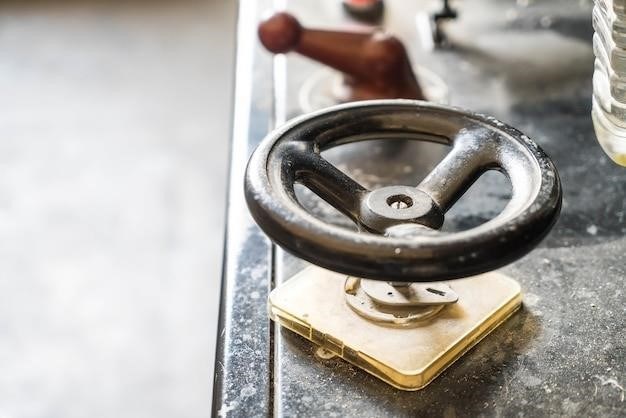Manual Clutch for Small Engines
A manual clutch is a mechanical device that allows the driver to control the transfer of power from the engine to the transmission in small engines․ It’s typically used in applications like mini bikes, go-karts, and small tractors; By engaging or disengaging the clutch, the driver can start, stop, and shift gears smoothly․ A manual clutch provides greater control over the engine’s power delivery, offering a more precise driving experience․
Introduction
In the world of small engines, power transmission is a crucial aspect that dictates the performance and functionality of various machines․ From go-karts zipping across tracks to mini bikes navigating trails, the ability to control power delivery is essential․ This is where manual clutches come into play, serving as a vital link between the engine’s power and the transmission’s gears․
A manual clutch, unlike its automatic counterpart, provides the driver with direct control over the flow of power․ This control allows for precise acceleration, smooth shifting, and the ability to bring the engine to a complete stop without stalling․ Understanding the principles behind manual clutches, their applications, and the benefits they offer is essential for anyone working with small engines․
This comprehensive guide will delve into the intricacies of manual clutches in small engines․ We will explore their basic functionality, different types, common applications, and the advantages and disadvantages associated with their use․ Additionally, we will provide insights into how a manual clutch works, the process of installing one, troubleshooting common issues, and maintaining it for optimal performance․ By the end of this exploration, you will gain a clear understanding of the role manual clutches play in small engines and how they contribute to a smoother, more controlled driving experience․
What is a Manual Clutch?
A manual clutch is a mechanical device that acts as a bridge between the engine and the transmission in a small engine․ It allows the driver to control the flow of power from the engine to the wheels, enabling them to start, stop, and shift gears smoothly․ Imagine a manual clutch as a switch that can be turned on or off, connecting or disconnecting the engine’s power to the transmission․
In its simplest form, a manual clutch consists of two main components⁚ a clutch plate and a pressure plate․ The clutch plate is a disc that is connected to the engine’s crankshaft, while the pressure plate is mounted to the transmission’s input shaft․ When the clutch pedal is depressed, the pressure plate disengages from the clutch plate, effectively disconnecting the engine from the transmission․ This allows the driver to shift gears without causing any damage to the transmission․
When the clutch pedal is released, the pressure plate engages with the clutch plate, connecting the engine to the transmission and allowing power to flow to the wheels․ The amount of pressure applied to the clutch plate determines the amount of power being transferred․ This allows the driver to control the engine’s power delivery, providing a more precise and engaging driving experience․
Types of Manual Clutches
While manual clutches for small engines share the fundamental principle of connecting and disconnecting power, they come in various types, each with its unique design and application․ Here are some common types of manual clutches used in small engines⁚
- Dry Clutch⁚ This is the most prevalent type, consisting of a clutch plate, pressure plate, and a spring system․ The clutch plate is typically made of metal or ceramic material with friction linings that engage with the pressure plate․ Dry clutches are simple, reliable, and relatively inexpensive․
- Wet Clutch⁚ Unlike dry clutches, wet clutches operate immersed in oil․ This lubrication helps reduce wear and heat generation, enhancing durability and performance․ Wet clutches are often found in high-performance applications where smooth engagement and high torque transfer are crucial․
- Multi-Plate Clutch⁚ This type uses multiple clutch plates and pressure plates stacked together, increasing the contact area and enhancing torque capacity․ Multi-plate clutches are typically found in applications that require high torque, such as heavy-duty machinery and racing vehicles․
- Centrifugal Clutch⁚ While technically an automatic clutch, centrifugal clutches are often used in small engines as a simplified alternative to manual clutches․ They engage automatically when the engine reaches a certain speed, eliminating the need for a clutch pedal․
The choice of clutch type depends on the specific application, power requirements, and desired performance characteristics․ In smaller engines, dry clutches are often the preferred choice due to their simplicity and affordability․ However, for demanding applications or where smooth engagement is critical, wet or multi-plate clutches may be better options․

Applications of Manual Clutches in Small Engines
Manual clutches are essential components in various small engine applications, playing a crucial role in power transmission and control․ Here are some common applications where manual clutches are utilized⁚
- Go-Karts⁚ Manual clutches are widely used in go-karts, enabling drivers to control engine power and shift gears smoothly․ This allows for precise acceleration and deceleration, enhancing the racing experience․
- Mini Bikes⁚ Similar to go-karts, mini bikes often employ manual clutches for similar reasons․ The manual clutch provides fine-tuned control over engine power, allowing for precise acceleration and maneuverability․
- Small Tractors⁚ Manual clutches are essential in small tractors, enabling the operator to engage and disengage the engine power to the wheels․ This control is critical for various tasks such as plowing, tilling, and mowing․
- Small Engines for Machinery⁚ Manual clutches are used in various small machinery applications, such as lawn mowers, generators, and pumps․ They allow for controlled power transmission and efficient operation of these machines․
- Custom-Built Vehicles⁚ In the realm of custom-built vehicles, such as small-scale cars or trucks, manual clutches provide the necessary control over engine power and transmission, enabling efficient operation and driving experience․
The use of manual clutches in these applications ensures efficient power transfer, smooth operation, and precise control over the engine, enhancing performance and functionality in a wide range of small engine-powered vehicles and machines․
Advantages of Manual Clutches
Manual clutches offer several advantages over automatic centrifugal clutches, particularly in small engine applications․ These advantages contribute to greater control, efficiency, and a more enjoyable driving experience․
- Precise Control⁚ Manual clutches provide the driver with direct control over the engine’s power transfer․ This allows for precise acceleration, deceleration, and shifting, resulting in a more responsive and controlled driving experience․ It’s particularly beneficial for applications like racing or maneuvering in tight spaces․
- Improved Fuel Efficiency⁚ By allowing the driver to disengage the engine from the transmission when not needed, manual clutches can contribute to improved fuel efficiency․ This is achieved by preventing unnecessary engine load and reducing fuel consumption during coasting or stopping․
- Greater Durability⁚ Manual clutches typically have a longer lifespan than centrifugal clutches due to their simpler design and fewer moving parts․ They are less prone to wear and tear, requiring less maintenance and potentially lasting longer under demanding conditions․
- Versatility⁚ Manual clutches are versatile and can be adapted to a wide range of small engine applications․ They can be customized to suit different power output requirements and operating conditions, making them suitable for various small vehicles and machines․
- Cost-Effectiveness⁚ In some cases, manual clutches can be more cost-effective than automatic centrifugal clutches․ Their simpler design and construction can translate into lower manufacturing and installation costs, making them an attractive option for budget-conscious users․
The advantages of manual clutches make them a preferred choice for many small engine applications, particularly when precise control, efficiency, and durability are paramount․
Disadvantages of Manual Clutches
While manual clutches offer several advantages, they also come with some inherent disadvantages that users need to consider․ These drawbacks can be mitigated with proper installation, maintenance, and driving techniques, but it’s important to be aware of them⁚
- Learning Curve⁚ Operating a manual clutch requires a learning curve․ Mastering the technique of engaging and disengaging the clutch smoothly, coordinating it with the throttle, and shifting gears can take time and practice․ For novice users, this can be challenging and frustrating initially․
- Potential for Damage⁚ Improper use of a manual clutch can lead to damage to the clutch plates, transmission, or even the engine․ Stalling the engine or shifting gears abruptly can cause excessive wear and tear, potentially requiring repairs or replacements․
- Reduced Convenience⁚ Manual clutches require more driver input than automatic clutches․ The driver needs to constantly engage and disengage the clutch, making it less convenient for everyday driving, especially in traffic or stop-and-go situations․
- Limited Applications⁚ Manual clutches are not suitable for all small engine applications․ They may not be ideal for high-speed racing or applications where a constant, smooth power delivery is crucial, like some agricultural equipment․
- Increased Complexity⁚ Manual clutches introduce a greater level of complexity to the drivetrain, requiring additional components and a more intricate installation process․ This can increase the overall cost and make troubleshooting more challenging․
Despite these disadvantages, manual clutches remain a popular choice for many small engine applications due to their advantages in terms of control, efficiency, and durability․ However, understanding and mitigating the potential drawbacks is crucial for optimal performance and longevity․
How a Manual Clutch Works

A manual clutch in a small engine operates based on the principle of friction and engagement․ It acts as a bridge between the engine’s power output and the transmission, allowing the driver to control the flow of power․ The basic components of a manual clutch include a clutch disc, pressure plate, and release bearing․ Here’s how it works⁚
- Engagement⁚ When the clutch pedal is released, the pressure plate applies force to the clutch disc, pressing it against the flywheel attached to the engine crankshaft․ This creates friction between the surfaces, transferring power from the engine to the transmission․ The engine’s power is now transmitted to the wheels, allowing the vehicle to move․
- Disengagement⁚ When the clutch pedal is depressed, the release bearing moves, pushing the pressure plate away from the clutch disc․ This disconnects the engine from the transmission, allowing the driver to shift gears or stop the vehicle without stalling․ The clutch disc is then disengaged, and the engine can run independently of the transmission․
- Smooth Engagement⁚ The clutch disc’s design, typically featuring friction plates, allows for a smooth engagement and disengagement․ The friction materials wear down over time, requiring periodic replacement to maintain proper clutch performance․
- Gear Shifting⁚ During gear shifting, the clutch is disengaged to disconnect the engine from the transmission․ This allows the gears to be shifted without causing damage to the transmission or engine․ Once the new gear is selected, the clutch is re-engaged to transfer power back to the wheels․
Understanding how a manual clutch works is essential for effective operation and maintenance․ Proper clutch engagement and disengagement are critical for smooth gear shifting, preventing damage to the drivetrain, and achieving optimal performance from the small engine․
Installing a Manual Clutch
Installing a manual clutch on a small engine can be a straightforward process, but it requires careful attention to detail and proper tools․ The specific steps may vary slightly depending on the make and model of the engine and clutch system․ However, the general process involves these key stages⁚
- Preparation⁚ Begin by gathering all necessary tools, including wrenches, sockets, a torque wrench, and a manual for your specific engine and clutch․ Ensure the engine is off and cooled down before starting the installation․
- Disassembly⁚ Remove the old clutch system, including the pressure plate, clutch disc, and release bearing․ Note the position and orientation of each component for proper reassembly;
- Inspect and Clean⁚ Carefully inspect the flywheel and transmission input shaft for any wear or damage․ Clean these surfaces thoroughly to ensure a smooth and secure fit for the new clutch components․
- Install Clutch Disc⁚ Align the new clutch disc with the flywheel and install it securely․ Ensure that the disc is centered and properly seated․
- Install Pressure Plate⁚ Position the new pressure plate onto the flywheel and tighten the bolts evenly using a torque wrench․ Refer to the manufacturer’s specifications for the correct torque settings․
- Install Release Bearing⁚ Attach the new release bearing to the clutch fork or mechanism, ensuring it is properly aligned and secured․
- Adjust Clutch Cable⁚ Adjust the clutch cable or linkage to ensure proper engagement and disengagement of the clutch․ Refer to your engine’s manual for instructions on adjusting the cable․
- Test and Adjust⁚ Start the engine and test the clutch operation, ensuring smooth engagement and disengagement․ If necessary, make minor adjustments to the cable or linkage to achieve optimal performance․
Remember, always refer to your engine’s manual for specific installation instructions․ If you are not comfortable performing this task yourself, consult a qualified mechanic for assistance․
Troubleshooting Manual Clutch Issues
A manual clutch in a small engine can experience various issues that can hinder its smooth operation․ These issues can range from simple adjustments to more complex problems requiring professional attention․ Here’s a guide to troubleshooting common manual clutch problems⁚
- Clutch Slipping⁚ This occurs when the clutch disc doesn’t engage fully, leading to a loss of power during acceleration․ Possible causes include worn clutch plates, insufficient pressure plate tension, or contamination with oil or grease․
- Clutch Chattering⁚ A chattering or rattling sound during clutch engagement indicates a problem with the clutch disc or pressure plate․ This can be caused by worn friction material, uneven pressure plate contact, or excessive wear on the flywheel․
- Clutch Dragging⁚ A dragging clutch doesn’t fully disengage, leading to engine strain and difficulty shifting gears․ This can be caused by a worn clutch disc, a sticking release bearing, or a problem with the clutch cable or linkage․
- Clutch Engagement Point⁚ If the clutch engagement point is too high or low, it can lead to difficulty shifting and uncomfortable driving․ Adjust the clutch cable or linkage to correct the engagement point․
- Clutch Pedal Sticking⁚ A sticking clutch pedal can be caused by a worn or damaged clutch cable, a sticking release bearing, or a problem with the clutch hydraulic system․ Inspect the cable, release bearing, and hydraulic system to identify the cause․
Always start by inspecting the clutch cable, linkage, and hydraulic system for any signs of wear, damage, or misalignment․ Check the clutch disc and pressure plate for wear or contamination․ If you are not comfortable troubleshooting these issues, consult a qualified mechanic for assistance․
Maintenance and Care
Proper maintenance and care are essential for ensuring the longevity and smooth operation of a manual clutch in a small engine․ Regular inspections, adjustments, and lubrication can help prevent premature wear and tear and minimize the risk of costly repairs․
- Clutch Cable Inspection⁚ Regularly inspect the clutch cable for signs of wear, fraying, or corrosion․ Lubricate the cable with a suitable cable lubricant to reduce friction and prevent rust․ Adjust the cable tension as needed to maintain the correct clutch engagement point․
- Clutch Linkage Inspection⁚ Inspect the clutch linkage for any signs of wear, damage, or misalignment․ Ensure that the linkage moves freely without any binding or resistance․ Lubricate the linkage with a suitable lubricant to reduce friction․
- Clutch Disc and Pressure Plate Inspection⁚ Periodically inspect the clutch disc and pressure plate for signs of wear, scoring, or glazing․ Replace worn or damaged components to prevent clutch slipping or chattering․
- Clutch Fluid Level Check⁚ If your small engine has a hydraulic clutch system, regularly check the fluid level and top it off as needed․ Use the recommended type of clutch fluid for your engine․
- Clutch Adjustment⁚ Periodically adjust the clutch cable or linkage to maintain the correct clutch engagement point․ This will help prevent clutch slipping and ensure smooth gear shifting․
Following these simple maintenance tips can help extend the life of your manual clutch and ensure reliable performance for years to come․ If you notice any unusual noises or feel any vibration during clutch operation, consult a qualified mechanic for further inspection and repair․



